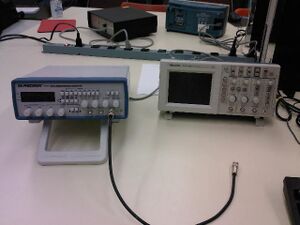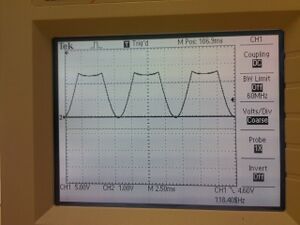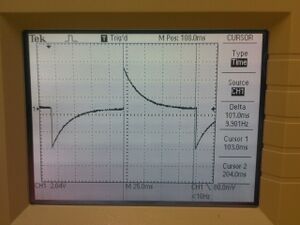Physics307L F09:People/Gonzalez/Oscilloscope
Oscilloscope
Equipment
SJK 17:56, 13 September 2009 (EDT)

Like I said on your primary notebook page, this information definitely needs to be in your primary notebook! Nice inclusion of photo and good job recording model numbers

The equipment being used for the oscilloscope lab is comprised of the following:
(1)Tektronix TDS 1002 oscilloscope
(1)BK Precision 10MHz sweep/function generator
(1)BNC cable
Procedure

SJK 18:02, 13 September 2009 (EDT)

The informal summary for a lab should succinctly state what was done and what the main results were. Thus, usually you will not copy over information directly from your primary lab notebook (as you do in this section). Instead, you'd be more likely to say, "Exact methods can be found in primary lab notebook (link). Briefly, our goal was to become familiar with the oscilloscope and to make some quantitative measurements of the fall time for AC coupling."
- Acquire the necessary equipment
- Plug in the power to the oscilloscope and function generator
- Next connect the function generator to the oscilloscope's channel 1
- Turn both pieces of equipment on, the power button on the oscilloscope is found on top, while the power button on the function generator is on the front "power" is labeled in red for easy identification.
- I set the sweep/function generator range to 100.
- I "played" with the oscilloscope until a sin function could be seen. Next I took some measurements of the initial sin function, using the grids, the cursors, and the measurement button. Note that the initial sin wave also had some amount of DC offset (the dial was turned up about halfway.
- Next I enlarged my power output using the sweep/function generator.
- Next I took the measurements of a small sin wave. This time I adjusted the wave by shrinking the output level from the sweep/function generator. (As shown to me by our TA: Pranav).
- Finally I measured my initial sin wave using DC a high DC offset (the nob was turned all the way to the right).
- Acquire the necessary equipment
Ac coupling

Which mode is better for viewing a ripple in DC coupling? AC coupling is better for this since Ac coupling doesn't allow DC current to pass through. The advantage being you can screen for "noise" with AC coupling.
Fall Time: 97.5ms
Cursor1: 103.0
Cursor2: 204.0 SJK 20:07, 13 September 2009 (EDT)

What are the units on these? Presenting measurements with units AND uncertainty is going to be a really important thing for every lab! Also, these numbers do not really have context, so the reader of the summary would not understand what you're talking about. A goal for the summary is that a reader not familiar with our lab setting would be able to understand your results. Thus, you'd want to say something like, "We measured the characteristic fall time for the AC coupling using two methods: Oscilloscope fall time and manual cursors...the cursor method produced an answer of ___ +/- ___ ms ... etc."
MEASUREMENTS
These measurements were taken in the lab, the grid refers to the measurement taken while viewing the grids on the oscilloscope; the cursor 1 and 2 boxes refer to the voltage measured at the maximum and minimum amplitude of the wave; while the measured box refers to the voltage taken from the "measure" button on the oscilloscope. The trial 4 also had a DC offset, unfortunately I forgot to record the exact value for the DC offset, however, the dial was turned all the way to the right.
Overall
- Overall I learned quite a bit about the oscilloscope. It has many functions and settings giving the user tremendous ability to analyze most voltage waveforms. I also learned to operate the oscilloscope and how to read it.
SJK 20:08, 13 September 2009 (EDT)

A conclusion like this is very good for your lab summary--good job putting it here.